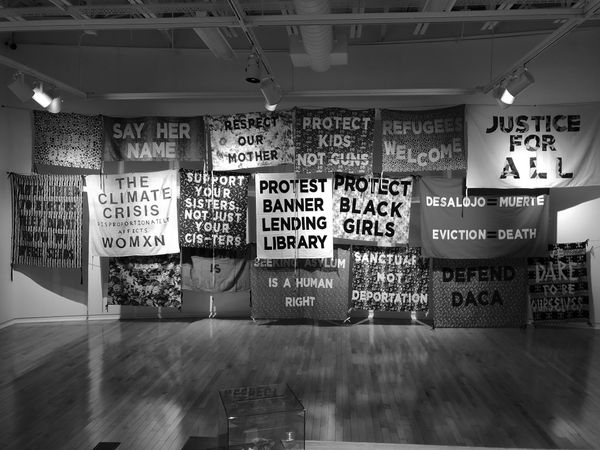Art, wages, politics, and kindness
by Claire Dodge
If we dig into the politics of art, we find there is a structural challenge. The wage gap is significant, with million dollar lofts popping up around Appleton, and full homeless shelters leaving people sleeping in the streets on negative ten degree winter nights. More than ever there’s luxury apartments, cafes and restaurants, and hip boutiques popping up, yet the average wage for those jobs remains around $8–10 an hour. With this growing wage gap, and the need to fill more jobs, how will we keep ourselves from being dragged under the current, and bought out? How will we get off our feet? How will anyone working in the service industry, or the anyone in the fabricated, condescending, literally non existent “unskilled labor” or “entry level” genre, establish themselves beyond the base level hierarchy of needs? The census bureau for income and poverty in the United States states that 39.7 million Americans are living in poverty. That statistic is only the number of individuals recorded, yet how can we measure the amount of people who constantly waiver above and below the poverty line due to unexpected costs such as medical bills, or car troubles? If your average person is suffering from this institution of debauchery and human debasement, how will an artist (not supported by a trust fund) be able to afford their canvasses, and their studio, their paints and pencils and charcoals, or space for paintings in a gallery? How will we try to keep access to the arts out of the puppeteering hands of the wealthy social elites? How will the lower or middle class artist be able to afford making donations to galleries, buy other local art, take trips to museums for inspiration? If we want art to continue as a platform of free expression, where we can hear the smallest of voices and the oppressed, we have to keep fighting for human rights, and not get caught and silenced in the rush of development. It feels as though we’re always trying to outrun a beast. We genuinely have to reconsider how we monetarily value labor, and the laborer, in order to afford to host a community of artists.
Of course we can draw on our receipt paper, we can use the same old sketchbook and minimize how much we take up on a page, we can buy used paints at the thrift store and paint on cardboard, but I think I can speak for us in saying that we would appreciate being able to afford more than just the bare minimum. Stop devaluing employees, invest in them so they can afford to thrive. I was blessed with wonderful art teachers, who became cynical as a result of intense budget cuts to our art program. These budget cuts reduced our average students ability to afford an art class because of the fees which were introduced for materials, field trips, and an overall reduction of utilization of materials. The noose was tied tighter around our beloved programs. Most art classes would be full, and a great majority of people relied on these periods to decompress and dive into a project, where we could sit quietly with one another and create. Most of you know– high school students can be cruel to each other, so the fact that these classes would harbor a safe and quiet environment for overstimulated and overwhelmed students to relax and express themselves was crucial. The teachers and students felt extremely threatened by these budget cuts from outside forces. We already had bare minimum, and they wanted to take away more. This is a fabulous example of how, in subtle ways, we disenchant and discourage people from participating in the arts. We can definitely improve as an artistically supportive community by looking at it holistically. There is inherent quality and necessity in creativity. Devaluing, and reducing accessibility to the arts yields devastating results.
Paying teachers better, allowing artists to price their art without debate, telling people they can make a career out of art, reducing budget cuts in primary and secondary schools is a start to positive reform for our communities. The arts are necessary and integral to all daily life, consumption, entertainment, etc. The more you open your eyes to this fact the more human the world feels. To think someone had designed the cute flowers on my favorite water bottle, or chose the nice plaid pattern on the cuffs of my jacket induces a sense of connectivity and joy within me.
It’s helpful for me to normalize art, whether it be checking up on what friends have put out lately, or giving myself the time and space to gaze at the recently hung local art at my favorite cafe, looking for up and coming events, etc. Art consumption and creation should be encouraged as a mindful habit and routine. It should be taught as a way to express our selves, meditate, decompress, and find joy. The relevant and helpful qualities of creativity, when nurtured, can blossom into wonderful talent, essential for quality of life and development–whether in architecture, general aesthetics, education, political awareness, therapies, interior design, fashion and textile design, industrial design, music for movies, symphony, distribution, dance for performance and emotional/physical well- being, writing for newspapers, editing, screenplays, novels, and so much more. These may seem like rudimentary concepts, but yet people incorrectly address art as a dead end profession. Everyone has heard of the condescending stereotype of the art school student, who’s relentlessly hopeful. When I was in the wake of leaving the soft pillow of high school, and expressing interest in pursuing a career involving the arts, I was discouraged by the challenging and doubtful mindsets surrounding me. It cast a shadow on my motivation, it slowed me down dramatically. Many people would say in a condescending, hostile, scrutinizing tone “What are you going to do with an arts degree?”, as if there aren’t thousands of careers which include it. It’s inspiring to envision art as woven into the fabric of our daily lives. We all need to make more room for creatives to be nurtured and supported because without that this world will fall into desolate dullness.
I found myself wanting to reject my creativity because of negative internalizations, and reconstruct an altogether different passion. This stunted me. I wasted two years at least trying to reconsider how else to go forward, and found myself spiraling, clouded with angst. It wasn’t until I met a relatively small community of artists and writers who were actively participating and validated my desire to draw and write. I’m so grateful for them. I started involving and reintroducing myself by seeing/being apart of a growing art community, whether it was hanging out at studio 222, becoming a member of the Trout Museum, going to contemporary dance events, DIY punk shows (RIP rad pad), frequenting The Draw, or going to free Lawrence recitals– my quality of life had significantly increased. There are hundreds of ways people can be supported in the arts, and I hope everyday we find a way to uplift it, and embrace its potential; on personal levels and grand schemes. Most importantly we have to hold a strong foundation for human rights before we can truly build anything great together.
Claire Dodge is a working class poet living in Appleton, WI, and is passionate about the arts, intersectional feminism, LGBTQIA+ rights, mental health, and anti-classism/fascism/racism.



